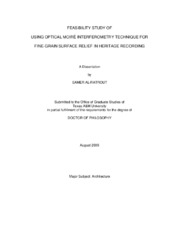| dc.contributor.advisor | Warden, Robert | |
| dc.creator | Al-Ratrout, Samer Abdulmunim | |
| dc.date.accessioned | 2005-11-01T15:44:35Z | |
| dc.date.available | 2005-11-01T15:44:35Z | |
| dc.date.created | 2005-08 | |
| dc.date.issued | 2005-11-01 | |
| dc.identifier.uri | https://hdl.handle.net/1969.1/2520 | |
| dc.description.abstract | In order to prepare for the prospective need for heritage 3D recording, the main
objective of this research was to investigate a new depth measuring method that
can reduce identified limitations of current point-to-point measuring approaches.
The limitations were time-money consumption, intrusiveness, accuracy
assumption and efficiency.
In many disciplines other than heritage recording, optical moir??
interferometry techniques (OMIT) are well developed as a measuring method
and are considered fast, non-intrusive, accurate, and efficient. Based on these
considerations, this research hypothesized that OMIT, as a measuring method,
is feasible with respect to time-consumption and accuracy in acquiring depth
measurement for fine-grain surface relief for historic recording.
To test this hypothesis, a feasibility investigation was carried in which
OMIT was used for surface relief topographic recording. This goal was
approached by performing a comparison study between the OMIT measuring
method as the investigated method and the hand measuring method as the
control method. For each method, the comparison required performing eight
experimental samplings of relief recording for a pre-designed physical model
surface.
The data collected from the hand measuring samples were the depth
measurements of predefined points on the model surface and the timeconsumption
for both measuring and data preparing processes. The data
collected from the OMIT measuring samples were moir?? dark fringes generated
on the model surface and the time-consumption for both moir?? generating and
data preparing processes. For measurement accuracy evaluation, the collected
depth data were prepared in the form of topographic contour drawings.
For the OMIT feasibility evaluation, a comparison was carried out to
examine the resulting topographic contour drawings for depth measurement
accuracy level and measuring process time-consumption.
In conclusion, the OMIT method showed higher depth measurement
accuracy levels and lower process time-consumption than the hand method. The
OMIT method also demonstrated less intrusiveness and more efficiency. This
superiority validates the feasibility of using fine-grain surface relief for heritage
recording purposes.
Finally, the observed advantages of the OMIT method were presented to
establish potentials for future developments and investigations. The observed
limitations of the method were also pointed out to establish trends for
recommendations and further studies. | en |
| dc.format.extent | 16643044 bytes | en |
| dc.format.medium | electronic | en |
| dc.format.mimetype | application/pdf | |
| dc.language.iso | en_US | |
| dc.publisher | Texas A&M University | |
| dc.subject | Heritage Recording | en |
| dc.subject | Architecture | en |
| dc.subject | Optical Moir?? | en |
| dc.subject | Moir?? Interferometry Technique | en |
| dc.subject | Fine-Grain Surface Relief | en |
| dc.subject | Depth Recording | en |
| dc.subject | 3D Recording | en |
| dc.subject | Surface Relief Topographic Recording | en |
| dc.subject | Integral Measurement Principle | en |
| dc.title | Feasibility study of using optical moir?? interferometry technique for fine-grain surface relief in heritage recording. | en |
| dc.type | Book | en |
| dc.type | Thesis | en |
| thesis.degree.department | Architecture | en |
| thesis.degree.discipline | Architecture | en |
| thesis.degree.grantor | Texas A&M University | en |
| thesis.degree.name | Doctor of Philosophy | en |
| thesis.degree.level | Doctoral | en |
| dc.contributor.committeeMember | Burt, Richard | |
| dc.contributor.committeeMember | House, Donald H. | |
| dc.contributor.committeeMember | Woodcock, David | |
| dc.type.genre | Electronic Dissertation | en |
| dc.type.material | text | en |
| dc.format.digitalOrigin | born digital | en |


